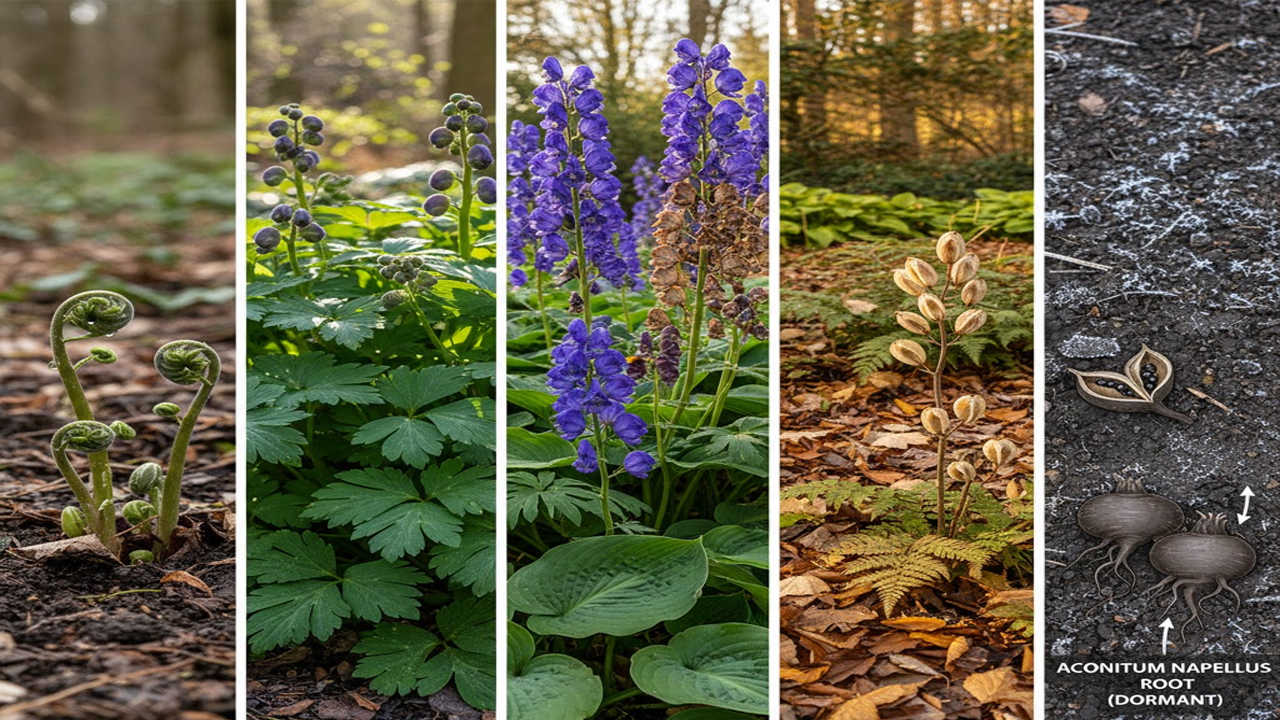Join on WhatsApp
Get the latest updates directly on WhatsApp – motivation, news & more!
Aconite, also known as monkshood or aconitum napellus, is a striking perennial admired for its hooded blue, purple, or white flowers. Native to mountainous regions of Europe and Asia, the aconite plant thrives in cool climates and woodland gardens. Despite its visual appeal, aconite aconitum is infamous for its toxicity. All parts of the plant are poisonous, especially the roots and seeds, making careful handling essential. Gardeners often choose aconite aconitum napellus for its dramatic vertical presence and late summer blooms, but awareness of its risks is crucial.
Choosing the Right Aconite Variety
There are several varieties of aconite to consider. Aconitum napellus monkshood is the most commonly cultivated, while winter aconite (eranthis) blooms earlier in the season with cheerful yellow flowers. Aconitum carmichaelii ‘Cloudy’ and aconitum royal flush offer unique color variations. Chinese aconite and aconitum chinese medicine types are also known, though they are more often used in traditional remedies than ornamental gardening. English woodland aconites and celandines and aconites are popular in temperate zones for naturalizing under trees.
Ideal Growing Conditions for Aconite Monkshood
Aconite thrives in partial shade and moist, well-drained soil rich in organic matter. It prefers cooler climates and benefits from protection against harsh afternoon sun. Planting aconitum napellus plant in woodland borders or alongside ferns and hostas creates a harmonious setting. Avoid overly dry or waterlogged soil, as aconite herb dislikes extremes. Aconite yellow and aconite white varieties may require slightly different light conditions, but all aconites benefit from consistent moisture and mulching to retain soil humidity.
Planting Aconite from Seed or Root
Growing aconite from seed requires patience. Aconite seed should be sown in autumn, as cold stratification improves germination. Alternatively, aconite plant for sale options often include bare root or potted specimens, which are easier for beginners. When planting, wear gloves to avoid skin contact with aconites poisonous sap. Space plants 12 to 18 inches apart to allow airflow and reduce fungal risk. Eranthis aconite and eranthis noel ayres varieties are best planted in drifts for a naturalized look.
Seasonal Care and Maintenance
Aconite napel is relatively low-maintenance once established. Water regularly during dry spells, especially in summer. Deadhead spent blooms to encourage further flowering and prevent self-seeding. In autumn, cut back the foliage after it dies down naturally. Aconitum napellus l and aconitum napellus 15 varieties may benefit from staking due to their height. Mulch in winter to protect roots, especially in colder zones. Avoid composting aconite clippings due to their toxicity.
Propagation and Division
Aconite can be propagated by division every few years in early spring or late autumn. Dig up the aconitum napellus plant carefully, divide the root clumps, and replant immediately. This method is safer than seed propagation and helps rejuvenate older plants. Aconitum varieties like aconitum camphora comp oleum and aconitum white monkshood respond well to division. Always wear gloves and wash tools thoroughly after handling aconite roots.
Toxicity and Safety Precautions
Aconite aconitum is one of the most toxic plants in horticulture. Aconites poisonous nature means ingestion or skin absorption can lead to serious health issues. Keep aconite away from children and pets, and label the plant clearly in your garden. Symptoms of aconite poisoning include nausea, numbness, and cardiac irregularities. Dried aconite retains its toxicity, so avoid using it in floral arrangements. Chinese monkshood and aconitum napellus use in traditional medicine must be handled by professionals.
Aconite in Homeopathy and Traditional Medicine
Despite its toxicity, aconite homeopathic medicine is widely used in diluted forms. Aconite 30, aconite30, and aconite 200 are common potencies for treating acute conditions like anxiety, fear, and cold symptoms. Aconite 30 for cold and aconite 30 for cough are popular remedies, especially for sudden onset illnesses. Aconite 200 for cold and cough and aconite for sore throat are also used in homeopathy. Aconite homeo medicine and aconite homeo remedies are believed to act quickly when symptoms appear suddenly.
Aconitum napellus homeopathy and aconitum napellus homeo are often prescribed for anxiety and shock. Aconite for anxiety and aconitum napellus for anxiety are considered effective in cases of panic or restlessness. Aconite 200 rajiv dixit and aconite 200c homeopathic remedy are referenced in traditional Indian homeopathy. Aconite 30ch, aconite 3x, aconite 6, aconite 6x, and aconite 1m homeopathy are other potencies used for various ailments. Aconite 1000 and aconite 200 mg are less common but still available.
Buying and Sourcing Aconite
If you’re looking for aconite plant online, ensure the seller provides clear safety guidelines. Aconite plant for sale listings should specify the variety, such as aconitum napellus plant or winter aconite. Aconite rhs and aconite near me searches can help locate local nurseries. Aconite price varies depending on the form-live plant, seed, or dried herb. Avoid purchasing aconite for internal use unless you’re working with a certified practitioner.
Common Uses and Cultural Significance
Aconite use spans ornamental gardening, homeopathy, and traditional Chinese medicine. Aconitum homeopathic medicine and aconitum napellus medicine are used globally, though with caution. Aconite treatment for high blood pressure, heart conditions, and fear is mentioned in historical texts, but modern use is strictly regulated. Aconite for heart and aconite for high blood pressure should never be self-administered. Aconite medicine and aconite abc homeopathy are niche references in alternative healing circles.
Final Thoughts on Growing Aconite
Growing aconite successfully requires balancing beauty with safety. Whether cultivating aconite blue, aconite white, or aconite yellow varieties, gardeners must respect the plant’s potent nature. Aconite remedy and aconite medicine have historical value, but the primary appeal for most is its dramatic presence in the garden. With proper care, awareness, and protective measures, aconite aconitum napellus can be a rewarding addition to temperate landscapes.
